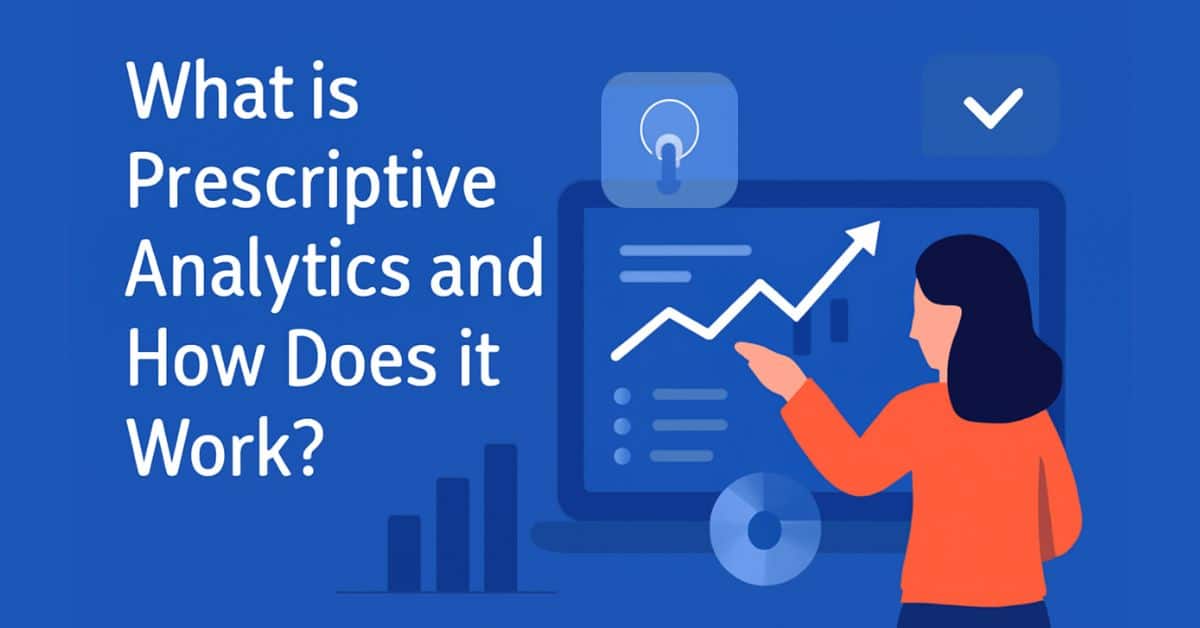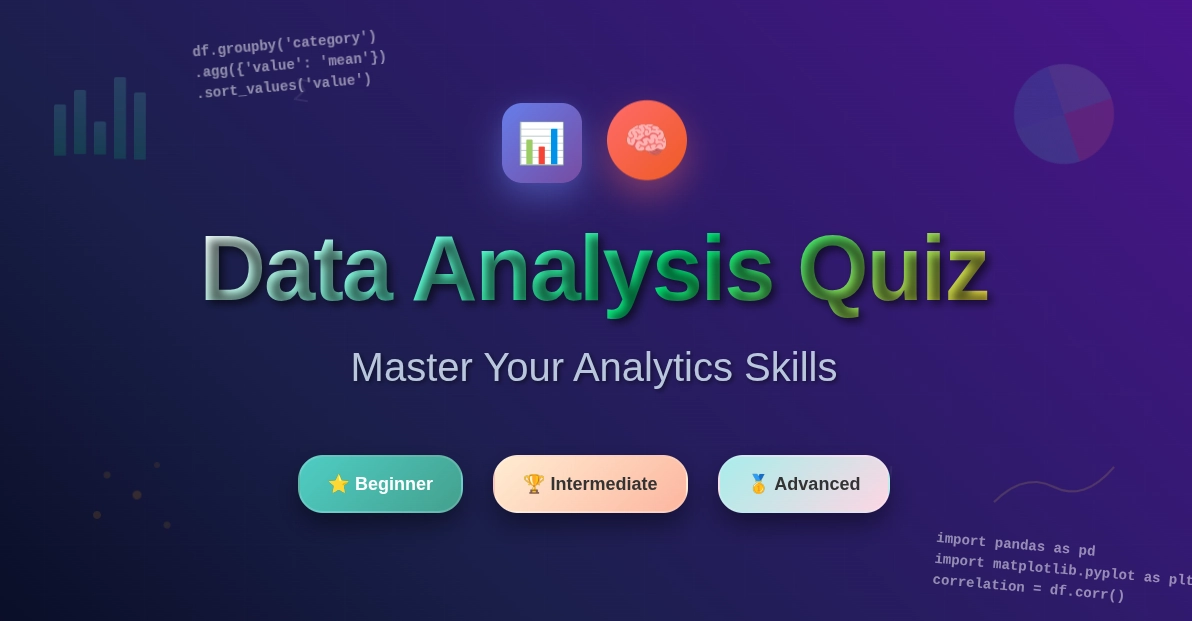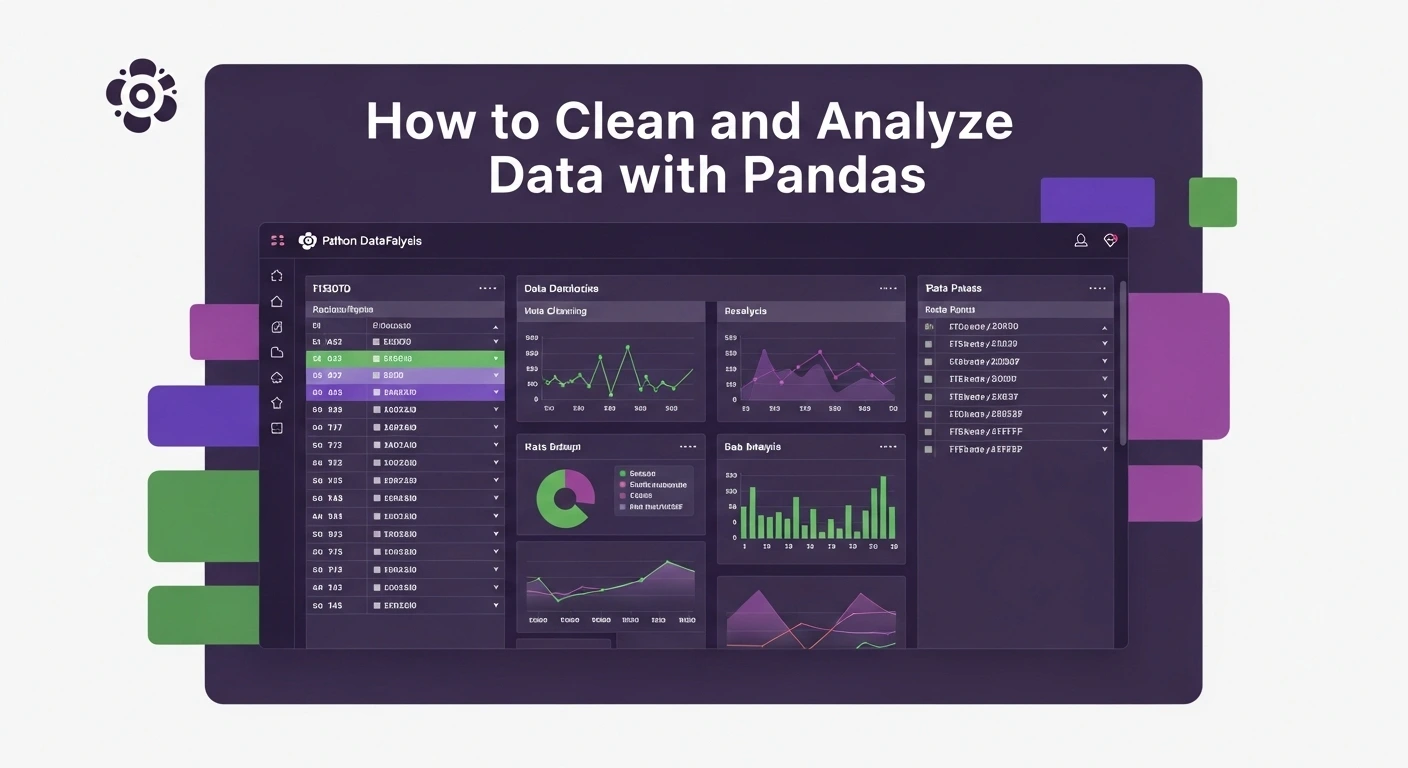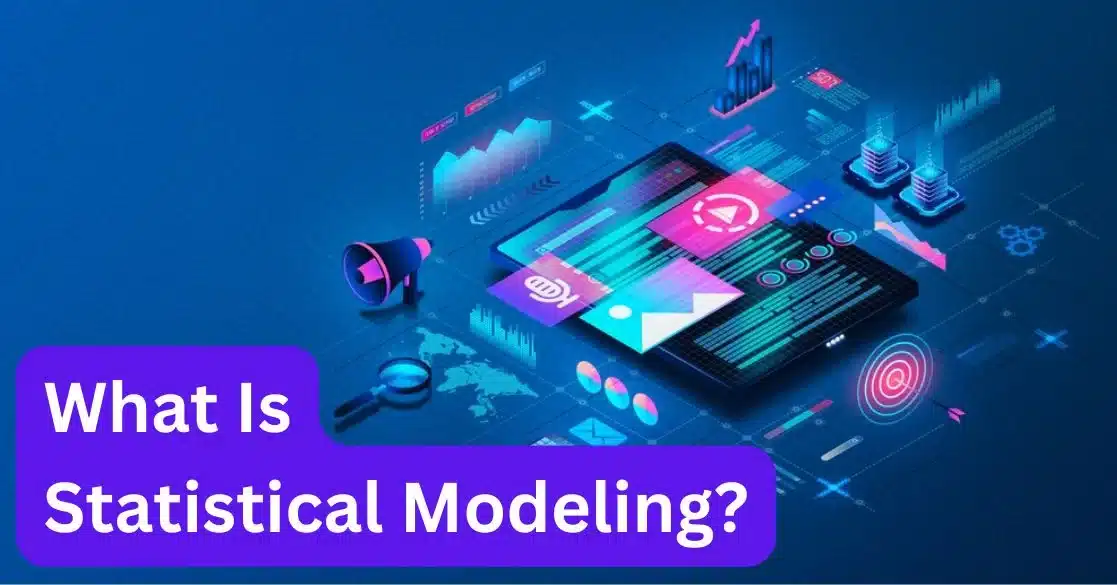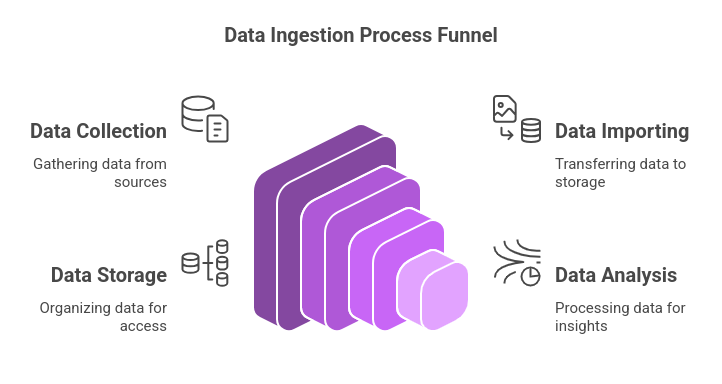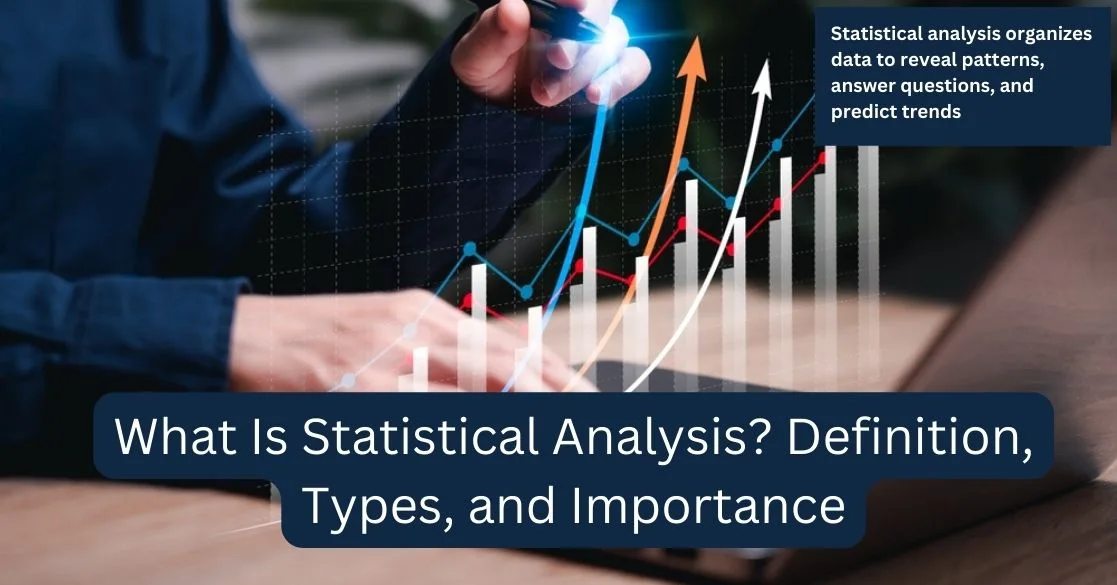Data possesses capabilities that are beyond mere history reporting and future prediction, as it can help generate recommendations regarding appropriate courses of action.
The analytics system, known as prescriptive analytics, comes into play in this scenario. The implementation of descriptive and predictive analytics by most businesses enables better insights, but prescriptive analytics provides actionable recommendations based on data-driven algorithms.
What is Prescriptive Analytics?
Prescriptive analytics uses data analytical techniques which go further than descriptive analytics and predictive modeling to suggest strategic execution guidance for organizational success. The system utilizes modern approaches which unite optimization with machine learning with decision analysis to produce recommendations through data analysis.
In brief, descriptive analytics provides an understanding of historical data through past events, whereas predictive analytics utilizes data to forecast future scenarios. Prescriptive analytics recommends the best course of action to achieve desired outcomes.
How Prescriptive Analytics Differs From Other Types Of Analytics?
The combination of optimization algorithms with machine learning and simulations in Prescriptive Analytics enables users to obtain optimal outcomes by providing recommended actions. Its main distinction from Descriptive Analytics comes through the summary function yet it contrasts with Predictive Analytics because it offers recommendations for optimal actions. This form of Analytics provides real-time solutions ranging from supply chain optimization to marketing plan recommendations.
How Prescriptive Analytics Works?
1. Defining the Problem or Objective
The first & most critical step in any prescriptive analytics project is to clearly define the problem or objective you are aiming to solve.
A goal without proper clarification results in analysis without direction, thus producing recommendations can be incorrect or useless. The process should include uniting stakeholders and identifying business requirements before establishing objectives that connect directly with organizational targets. You need to understand
- What is the key challenge?
- What outcomes are desired?
- What specific decision do you want to optimize?
For instance, a retail business might define the objective as "Increase profit margins by recommending dynamic pricing strategies during peak shopping seasons."
2. Data Collection & Preprocessing
Moving ahead from defining the problem, you need to proceed with data collection.
The collection of proper data requires both internal data sources, including sales figures and customer patterns derived from inventory quantities, as well as external resources, such as market information, competitor pricing, and weather conditions.
However, raw dataset typically carries various inconsistencies and missing values along with noise. Therefore, data preprocessing becomes crucial to clean & transform the data into a usable format.
- Data collection involves sourcing information from various systems like CRM, ERP, & external databases.
- Data preprocessing consists of three primary steps such as duplicate removal, value handling, and normalization to achieve consistent data formats.
For example:
Your optimization of marketing strategies would require gathering customer data that contains information about demographics and purchasing history, as well as interactions with past campaigns. After collecting the data, you need to standardize it through preprocessing operations before beginning the analysis.
3. Feature Selection & Engineering
Feature selection and engineering processes start after the data becomes available for analysis.
In this process, you must identify every variable that can impact the final result of the problem. The data points need to be analyzed, with priority given to those features that deliver the most relevant information. The process of feature engineering allows researchers to transform original variables into meaningful new features.

For example, in a recommendation system, the essential features would consist of "customer age" and "purchase frequency." The introduction of "average order value" as a new feature would enhance your ability to forecast customers with high purchase values.
4. Applying Descriptive & Predictive Analytics as a Foundation
The implementation of prescriptive analytics depends on building descriptive and predictive analytics first.
Through descriptive analytics, users receive historical trend information, whereas predictive analytics determines future trends by analyzing past data patterns. The information derived from descriptive and predictive analytics becomes the fundamental building blocks for developing prescriptive models.

For example, using descriptive analytics, we learn that sales generally increase during holidays. Predictive analytics estimates a 15% sales growth, enabling prescriptive models to develop price recommendations.
5. Building Prescriptive Models (Optimization, Machine Learning, AI)
The core of prescriptive analytics lies in the modeling phase. Here, you apply advanced techniques like optimization algorithms, machine learning algorithms, & AI to generate actionable recommendations. These models help you decide the best course of action based on the data & the defined objectives.
For example, an optimization model could suggest the most cost-effective route for delivery trucks. In contrast, an AI-based model could recommend the best pricing strategy to maximize revenue during a flash sale.
6. Deployment & Integration into Business Processes
Prescriptive model deployment follows the model creation process.
The next phase involves implementing these insights and recommendations directly into operational business flows to enable immediate decision-making. The deployment of the model occurs through integration with existing business software systems, facilitating the implementation of daily recommendations.
An e-commerce platform receives prescriptive analytics pricing models that enable automatic price adjustments through current demand analysis combined with competitor pricing and customer interaction data.
7. Ongoing Monitoring & Refinement
The last phase of prescriptive analytics consists of continuous evaluation and model optimization.
It is essential to monitor both changing business conditions and new data appearances because this ensures proper model performance evaluation. Regular model reviews enable organizations to identify areas for improvement while ensuring the model remains relevant and applicable.
The process of monitoring includes tracking key performance indicators (KPIs) for analyzing the outcomes of recommended actions.
The refinement stage necessitates adjustments to the model, which stem from either newly acquired data, business alterations, or market derivative shifts.
For example, a pricing model loses effectiveness as market conditions evolve, so updated data or new features can help you refine it to generate valuable recommendations again.
Key Technologies & Methods Used In Optimization Algorithms
1. Optimization Algorithms
Prescriptive analytics consists of optimization as its fundamental principle. Optimization algorithms help businesses find the most optimal solution by applying set constraints and defined objectives. Optimization algorithms are designed to achieve target objectives by maximizing or minimizing output.
- Linear Programming (LP): A mathematical method for determining the best outcome in a model with linear relationships between variables. It's used in supply chain optimization, resource allocation, & production scheduling.
- Integer Programming (IP): Similar to LP, but with the added constraint that some variables must be whole numbers. It's commonly used in routing problems like delivery routes or workforce scheduling.
- Genetic Algorithms: Inspired by natural selection, these algorithms are used for complex optimization problems where traditional methods might struggle. They're instrumental in scenarios like network design or multi-objective optimization.
Example: The transportation company applies optimization algorithms to create optimal delivery routes that balance fuel expenses against delivery time and driver scheduling needs.
2. Machine Learning Models
Machine learning models within prescriptive analytics enable researchers to discover patterns along with future outcome predictions to create actionable recommendations. Machine learning can process extensive and complex datasets that go beyond the capabilities of conventional statistical analysis methods.
- Supervised Learning: ML models are trained on labeled data to predict outcomes. Techniques like regression & classification are standard, & they're used for tasks such as demand forecasting, customer segmentation, or risk assessment.
- Unsupervised Learning: This method finds hidden patterns in data without pre-labeled outcomes. Clustering & association rules are examples of unsupervised learning, which can help in customer profiling or identifying new market opportunities.
- Reinforcement Learning: A type of machine learning where models learn by interacting with an environment & receiving feedback in the form of rewards or penalties. This is used in real-time decision-making, like adjusting pricing dynamically based on customer behavior.
Example: Machine learning models analyze customer data to generate personalized recommendations for products while improving marketing strategies through individual consumer preferences.
3. Heuristics and Rule-Based Systems
Heuristics and rule-based systems develop decision frameworks by employing simplified practical techniques to find solutions to complex problems. The systems base their decisions on either if-then rules or shortcuts, which produce satisfactory solutions for challenging issues, especially when exact optimization takes too much time or computation power.
- Heuristics: These are problem-solving methods that employ trial-and-error approaches to find solutions quickly. While they may not guarantee the optimal solution, they offer satisfactory results for complex problems.
- Rule-Based Systems: These systems use predefined rules to make decisions. For instance, if a customer buys a particular product, the system might recommend complementary products using rule-based logic.
Example: An e-commerce platform could implement a rule-based system that automatically triggers discounts for customers who fulfill specific purchasing thresholds (such as buying two or more items) to optimize sales performance in real-time.
4. Simulation & Scenario Analysis
Simulation & scenario analysis function as valuable techniques that enable the creation of real-world system models and the prediction of scenario outcomes. The techniques prove beneficial within unpredictable systems, including supply chain management, financial planning, and risk management situations.
- Monte Carlo Simulation: This method uses random sampling & statistical modeling to simulate a range of possible outcomes in a system. It is widely used in risk analysis, where it helps model uncertainty & assess potential risks.
- Scenario Analysis: This involves creating multiple possible future scenarios based on different assumptions or input variables. The model is then used to analyze the impacts of each scenario, helping businesses prepare for other future outcomes.
- Discrete Event Simulation (DES): This method models the operation of a system as a sequence of events. It helps optimize processes such as manufacturing or queuing systems, where timing and event occurrence are crucial.
Example: A manufacturing company would employ simulation to construct supply chain models of various disruptions, including material shortages, and evaluate strategic adjustments, such as stock manipulation and supply network exploration, through virtual tests.
Benefits of Prescriptive Analytics

1. Enables Data-Driven, Actionable Recommendations
Prescriptive analytics transforms raw data into strategic guidance. It doesn’t just highlight what might happen, it tells you what you should do next.
- Moves decision-making from intuition to intelligent algorithms.
- Helps organizations shift from reactive to proactive strategies.
- Offers specific actions backed by evidence, not guesswork.
Example: A retailer can receive precise recommendations on which products to restock, in what quantity, & at which locations to maximize profits & reduce waste.
2. Optimizes Business Processes & Resource Allocation
At its core, prescriptive analytics aims to maximize efficiency & output. Whether it’s logistics, staffing, supply chains, or marketing, prescriptive models help fine-tune every operation.
- Allocates resources where they generate the most value.
- Improves scheduling, routing, & inventory management.
- Reduces operational costs & minimizes delays.
3. Reduces Risk & Prevents Fraud
By integrating with predictive models, prescriptive analytics can suggest ways to mitigate risk & prevent fraud before it occurs.
- Identifies risky transactions or behaviors & suggests preventive measures.
- Helps financial institutions meet compliance requirements efficiently.
- Supports insurance companies in claims management by flagging anomalies.
Example: A bank generates automated suggestions through prescriptive analytics to block or flag suspicious transactions, thereby helping to reduce financial losses while strengthening its security measures.
4. Enhances Customer Experience Through Personalization
Prescriptive analytics empowers businesses to deliver personalized experiences based on individual customer behaviors, preferences, & historical data.
- Tailor's product recommendations, content, & promotions.
- Increases customer engagement & retention.
- Improves customer satisfaction & lifetime value.
Example: The personalization of recommendation algorithms on streaming platforms through prescriptive analytics enables matching content to individual user preferences, resulting in improved customer satisfaction rates and viewer retention.
5. Supports Proactive Decision-Making
One of its most strategic benefits, prescriptive analytics enables businesses to act proactively before problems arise or opportunities are missed.
- Anticipates changes in demand, supply, or customer behavior.
- Helps leaders plan for multiple scenarios & take preventive actions.
- Aligns decisions with long-term business objectives.
Example: A manufacturer can make early changes to their production planning through prescriptive insights that reveal upcoming supply chain disruptions.
Real-World Applications & Examples of Prescriptive Analytics
1. Customer Segmentation & Personalized Marketing
Businesses are using prescriptive analytics to move beyond general marketing strategies & instead tailor offers to individual customer preferences.
Example: An e-commerce platform uses prescriptive models to determine which promotions should be sent to which users to maximize conversion rates while reducing discount overuse.
2. Fraud Detection & Risk Assessment in Finance
Financial organizations utilize prescriptive analytics tools to identify potential fraudulent activities in advance, thereby enhancing their operations through more efficient risk management.
Example- The credit card company detects unusual payments, after which it activates blocking card access and requires customers to verify their activities.
3. Demand Forecasting & Inventory Optimization in Retail
Retailers employ prescriptive analytics to get better supply and demand synchronization, thus avoiding both product shortages and excess inventory levels.
Example: Analysis of prescriptive data helps a grocery chain determine the suitable quantities of fresh produce for each store location, minimizing waste while meeting consumer market needs.
4. Predictive Maintenance in Manufacturing
In industrial settings, prescriptive analytics minimizes equipment downtime by not just predicting failures, but also recommending when & how to act.
Example: A car manufacturing plant receives alerts that a specific machine is likely to fail within 72 hours, along with a recommendation to service it during off-peak hours to avoid production delays.
5. Treatment Recommendations in Healthcare
Prescriptive analytics is transforming patient care by delivering personalized treatment plans that are evidence-based & outcome-driven.
Example: A hospital uses prescriptive analytics to suggest treatment plans for diabetic patients based on real-time health data, improving adherence & long-term outcomes.
Conclusion
Business decisions are being transformed through prescriptive analytics, as this technology converts raw data into actionable, specific strategies. The power to predict alongside prescription functions as a modern business game-changer for operations optimization, risk mitigation, and customer experience personalization.
If you’re looking to master the skills needed to thrive in this data-driven aspect, Great Learning’s PG Program in Data Science and Business Analytics offers hands-on training in analytics, machine learning, & optimization techniques to help you drive impactful decisions in any industry.
